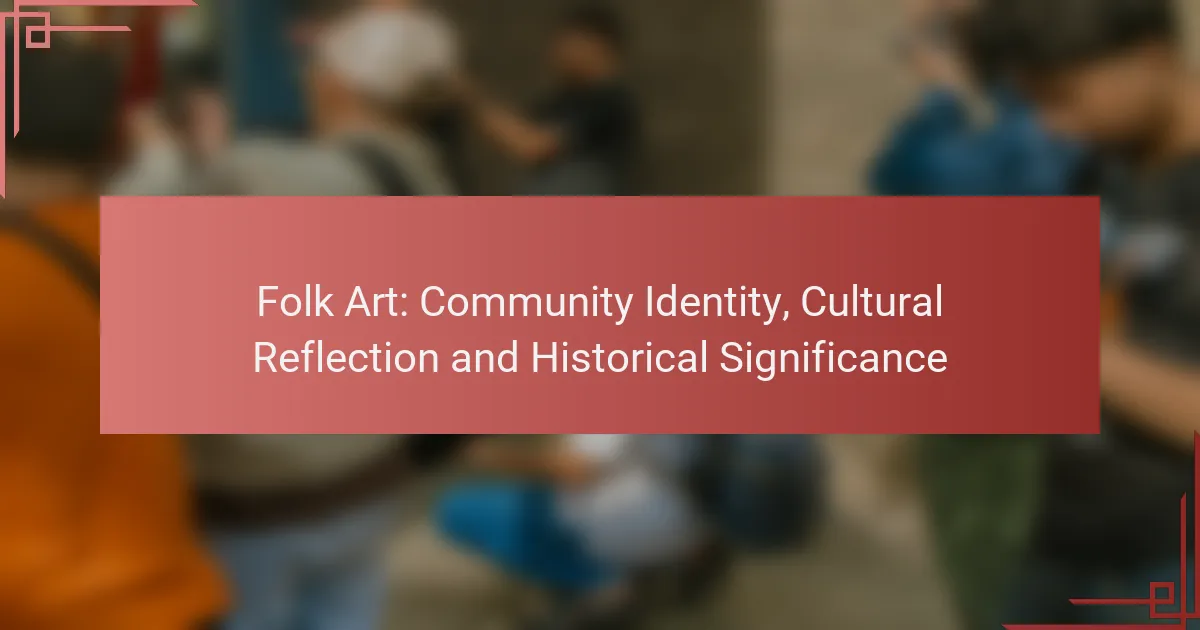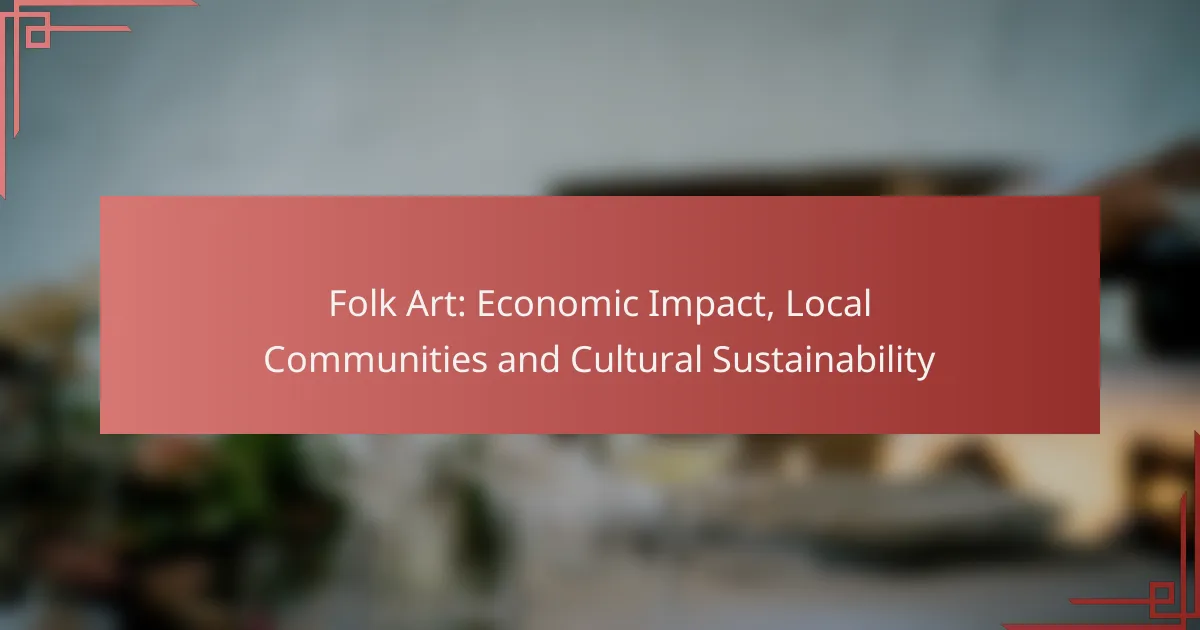Folk art is vital for preserving cultural heritage, as it embodies the traditions and histories of diverse communities across the United States. Through various preservation methods, such as documentation and community engagement, folk art not only maintains its cultural significance but also enhances community value by fostering identity and social connections.
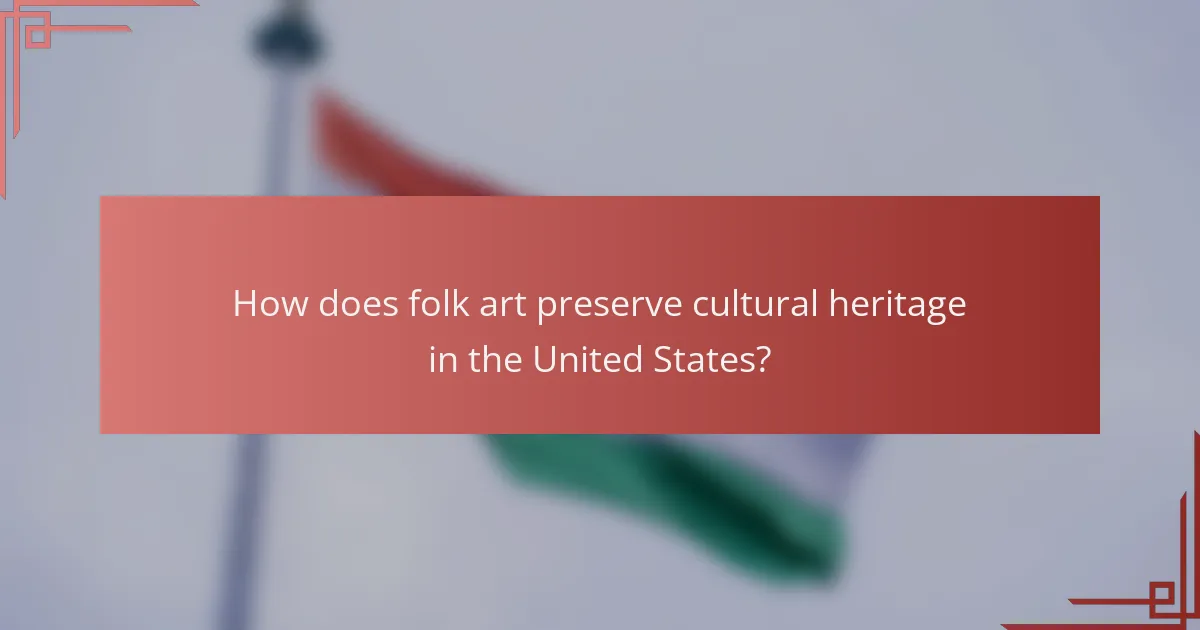
How does folk art preserve cultural heritage in the United States?
Folk art plays a crucial role in preserving cultural heritage in the United States by reflecting the traditions, values, and histories of various communities. Through the creation and continuation of artistic practices, folk art maintains connections to cultural identities and fosters a sense of belonging among diverse groups.
Community engagement in folk art
Community engagement is vital in the realm of folk art, as it encourages collaboration and participation among local artists and residents. Workshops, festivals, and exhibitions often serve as platforms for sharing knowledge and skills, allowing community members to learn from one another and celebrate their heritage.
Additionally, engaging with folk art can strengthen community bonds and promote cultural pride. By involving various generations, communities ensure that traditional practices are passed down, keeping their cultural narratives alive.
Historical significance of folk art
The historical significance of folk art lies in its ability to document the experiences and stories of specific communities throughout American history. Each piece often reflects the socio-economic conditions, migrations, and cultural exchanges that have shaped the nation.
For instance, the quilts of the Appalachian region not only serve as functional items but also tell stories of family lineage and local traditions. Such artworks provide insight into the past, helping to preserve the unique narratives of different cultural groups.
Artistic techniques and traditions
Folk art encompasses a variety of artistic techniques and traditions that are often passed down through generations. Techniques may include woodworking, weaving, pottery, and painting, each reflecting the materials and resources available in a community.
For example, Native American beadwork showcases intricate designs that convey cultural significance and storytelling. Similarly, Mexican folk art often employs vibrant colors and patterns that celebrate heritage and identity. Understanding these techniques helps to appreciate the depth and diversity of folk art as a vital aspect of cultural preservation.
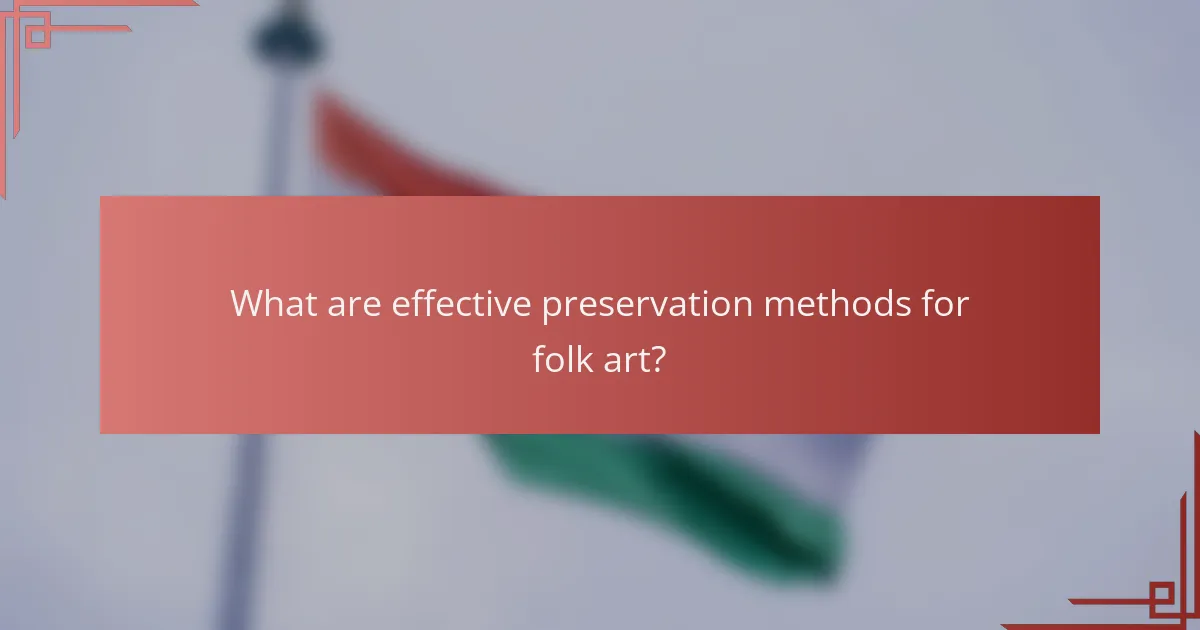
What are effective preservation methods for folk art?
Effective preservation methods for folk art include documentation, restoration practices, and community engagement through workshops. These strategies help maintain the cultural significance and physical integrity of folk art while fostering appreciation within communities.
Documentation and archiving
Documentation and archiving are crucial for preserving folk art, as they create a record of the artwork’s history, context, and techniques. This can involve photographing pieces, writing detailed descriptions, and collecting oral histories from artists or community members.
Utilizing digital platforms can enhance accessibility, allowing broader audiences to engage with the art. Local archives or museums often provide resources for proper documentation, ensuring that the information is preserved for future generations.
Restoration practices
Restoration practices focus on repairing and maintaining folk art to prevent deterioration. This may include cleaning, repairing structural damage, or using conservation-grade materials that match the original work. It’s essential to balance restoration with the preservation of the artwork’s authenticity.
Professionals often follow guidelines set by organizations like the American Institute for Conservation, which emphasizes minimal intervention. Collaborating with local artisans can also ensure that restoration respects traditional methods and materials.
Community workshops and education
Community workshops and education initiatives play a vital role in preserving folk art by engaging local populations. These programs can teach traditional techniques to new generations, ensuring that skills are passed down and maintained.
Organizing events such as craft fairs or art exhibitions can also raise awareness and appreciation for folk art. Providing resources and training in schools or community centers encourages participation and fosters a sense of ownership over local cultural heritage.

How does folk art contribute to community value?
Folk art enhances community value by fostering cultural identity, promoting economic growth, and strengthening social bonds. It serves as a medium for expressing local traditions and values, which can lead to a more cohesive community.
Economic impact through tourism
Folk art can significantly boost local economies by attracting tourists interested in authentic cultural experiences. Communities that promote their folk art often see increased foot traffic, which benefits local businesses such as shops, restaurants, and hotels.
For example, festivals showcasing local crafts and performances can draw visitors from outside the region, leading to a spike in revenue during these events. Communities can capitalize on this by developing art trails or markets that highlight local artisans.
Social cohesion and identity
Folk art plays a crucial role in fostering social cohesion by bringing people together around shared cultural practices. Engaging in folk art activities, such as workshops or community gatherings, helps strengthen relationships among residents and reinforces a sense of belonging.
Moreover, folk art serves as a visual representation of a community’s identity, allowing residents to connect with their heritage. This shared understanding can lead to greater pride and commitment to preserving local traditions.
Intergenerational knowledge transfer
Folk art facilitates the transfer of knowledge and skills between generations, ensuring that traditional practices are not lost. Older artisans often mentor younger community members, teaching them techniques and stories that enrich their cultural understanding.
This mentorship can take place in informal settings, such as family gatherings, or through organized programs in schools and community centers. Encouraging youth participation in folk art not only preserves these traditions but also empowers the next generation to innovate and adapt them for contemporary contexts.
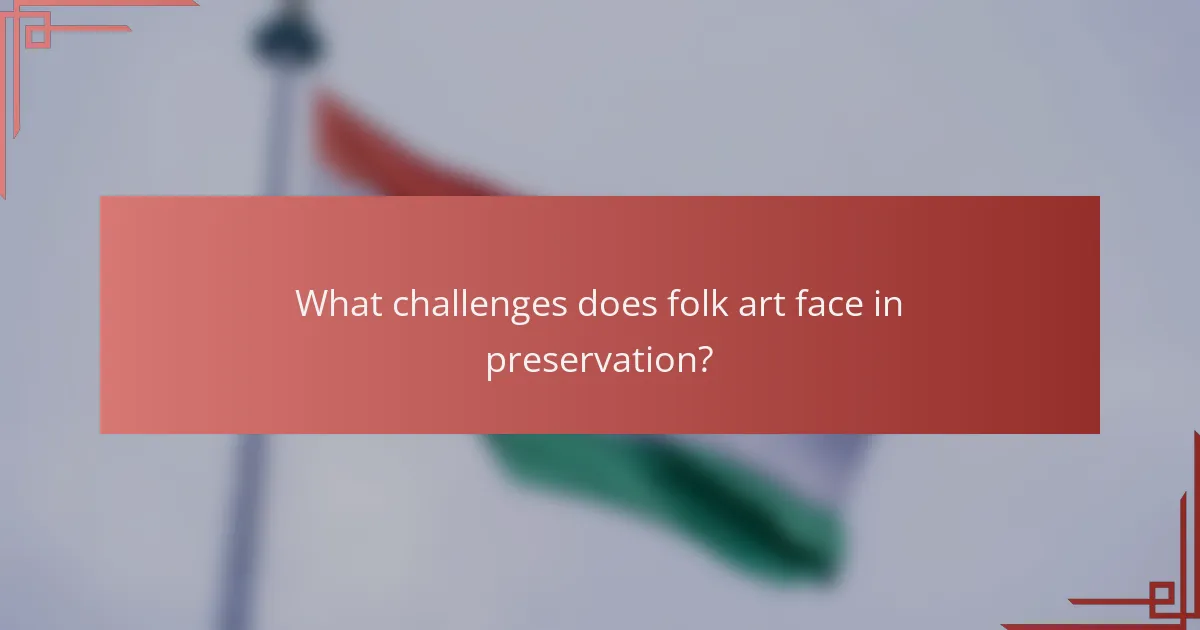
What challenges does folk art face in preservation?
Folk art faces several challenges in preservation, primarily stemming from commercialization, funding limitations, and evolving cultural landscapes. These factors can threaten the authenticity and continuity of traditional practices, making it essential to address them effectively.
Commercialization and authenticity
Commercialization can dilute the authenticity of folk art as artists may alter their work to appeal to market demands. This shift often leads to a loss of traditional techniques and cultural significance, as the focus shifts from heritage to profit. For example, mass-produced items may mimic folk art styles but lack the unique qualities that define genuine pieces.
To maintain authenticity, artists and communities should prioritize the preservation of traditional methods and educate consumers about the value of original works. Supporting local artisans through craft fairs and exhibitions can also help reinforce the importance of authentic folk art.
Funding and resource allocation
Limited funding and resources pose significant barriers to the preservation of folk art. Many artists rely on grants or community support, which can be inconsistent and insufficient. This financial instability can hinder the ability to maintain traditional practices and pass them on to future generations.
Communities can enhance funding opportunities by forming partnerships with cultural organizations and applying for grants specifically aimed at preserving folk art. Establishing local initiatives or crowdfunding campaigns can also provide necessary financial support for artists and preservation projects.
Changing cultural landscapes
As societies evolve, cultural landscapes shift, impacting the relevance and practice of folk art. Globalization and urbanization can lead to the marginalization of traditional art forms, as younger generations may gravitate towards contemporary styles and mediums. This shift can result in a decline in the transmission of folk art knowledge.
To counteract this trend, communities should actively engage younger audiences through workshops and educational programs that highlight the importance of folk art. Integrating folk art into modern contexts, such as collaborations with contemporary artists, can also help keep these traditions alive and relevant.
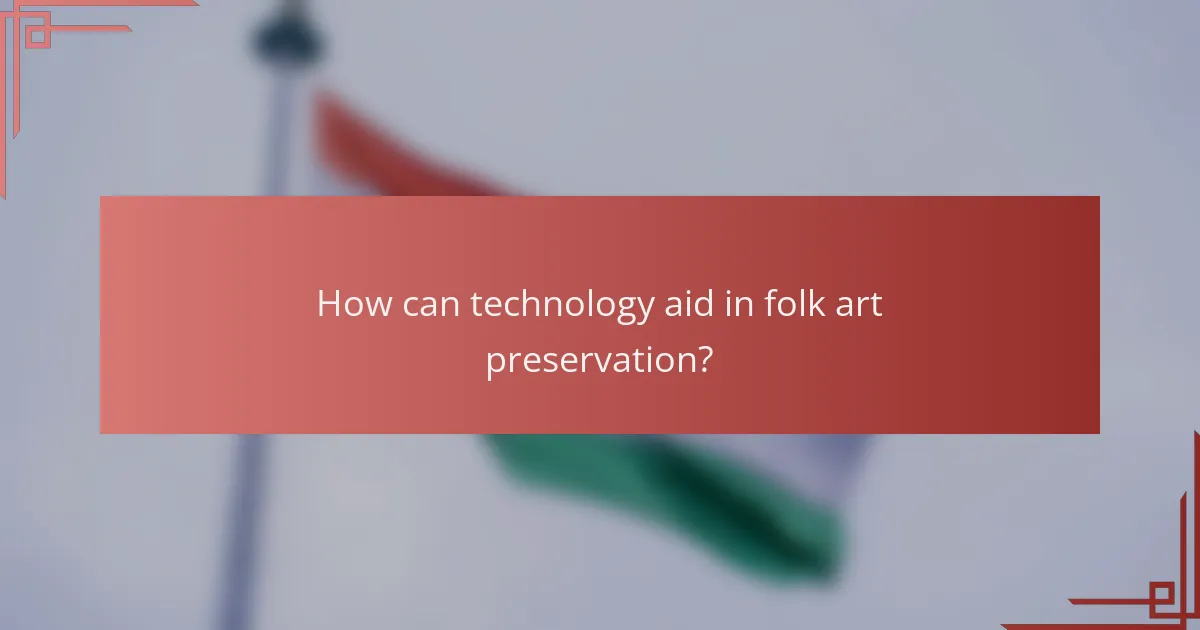
How can technology aid in folk art preservation?
Technology plays a crucial role in preserving folk art by providing innovative methods for documentation, sharing, and community engagement. Tools such as digital archiving, virtual reality, and online platforms enhance accessibility and foster appreciation for cultural heritage.
Digital archiving solutions
Digital archiving involves creating electronic records of folk art, which can include high-resolution images, videos, and detailed descriptions. This method allows for the preservation of artworks that may be physically deteriorating, ensuring they remain accessible for future generations.
When implementing digital archiving, consider using widely accepted formats and metadata standards to enhance searchability. Tools like Adobe Photoshop for image editing and software like Omeka for online collections can streamline the process.
Virtual reality experiences
Virtual reality (VR) can immerse users in the world of folk art, allowing them to experience cultural artifacts in a three-dimensional space. This technology can recreate traditional environments and showcase art in context, enhancing understanding and appreciation.
To create effective VR experiences, collaborate with local artists and cultural experts to ensure authenticity. Platforms like Oculus or Unity can be utilized to develop engaging content that resonates with diverse audiences.
Online community platforms
Online community platforms enable artists, enthusiasts, and scholars to connect, share knowledge, and collaborate on folk art projects. These platforms can host forums, workshops, and exhibitions, fostering a sense of community and collective ownership of cultural heritage.
Consider using social media groups or dedicated websites to facilitate discussions and share resources. Ensure that these platforms are user-friendly and accessible to encourage participation from a wide audience.

